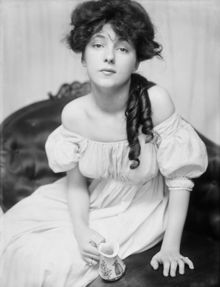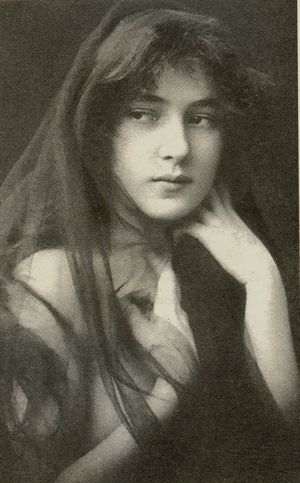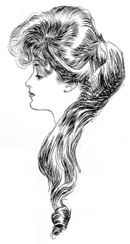Evelyn Nesbit: Difference between revisions
No edit summary |
m (Text replacement - "{{cat1|" to "{{cat|") |
||
| Line 139: | Line 139: | ||
{{wr}} | {{wr}} | ||
{{ | {{cat|Models}} | ||
{{footer}} | {{footer}} | ||
Revision as of 07:53, 27 June 2022
Click here for Nexus:Evelyn Nesbit |
Evelyn Nesbit (born Florence Evelyn Nesbit, December 25, 1884 or 1885 – January 17, 1967) was an American artists' model, chorus girl, and actress.
In the early part of the 20th century, Nesbit's figure and face appeared frequently in mass circulation newspapers and magazine advertisements, on souvenir items, and in calendars, making her a celebrity. Her career began in her early teens in Philadelphia and continued in New York, where she posed for a cadre of respected artists of the era, including James Carroll Beckwith, Frederick S. Church, and notably Charles Dana Gibson, who idealized her as a "Gibson Girl". She had the distinction of being an early fashion and artists' model in an era when both fashion photography (as an advertising medium) and the pin-up (as an art genre) were just beginning their ascendancy.
Nesbit received further worldwide attention when her husband, the mentally unstable multimillionaire Harry Kendall Thaw, shot and killed the prominent architect and New York socialite Stanford White in front of hundreds of witnesses at the rooftop theater of Madison Square Garden on the evening of June 25, 1906, leading to what the press would call the "Trial of the Century". During the trial, Nesbit testified that five years earlier, when she was a stage performer at the age of 15 or 16, she had attracted the attention of White, who first gained her and her mother's trust, then sexually assaulted her while she was unconscious, and then had a subsequent romantic and sexual relationship with her that continued for some time.
Early life
Evelyn's mother was unable to provide either business acumen or guardianship for her daughter. In a later interview with reporters, Mrs. Nesbit maintained: "I never allowed Evelyn to pose in the altogether" (in the nude). Two artworks, one by Frederick Church, and another by Beckwith in 1901, contradict Mrs. Nesbit, as they display a skimpily clad or partially nude Evelyn.
Nesbit became one of the most in-demand artists' models in New York. Otto Sarony and Rudolf Eickemeyer were among those who took striking photographs of her.
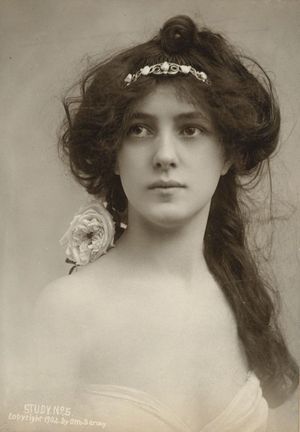
Nesbit became a popular cover face on women's magazines of the period, including Vanity Fair, Harper's Bazaar, The Delineator, Women's Home Companion, Ladies' Home Journal, and Cosmopolitan. Inside the advertising pages of these magazines and in newspapers, her role became the business of creating consumer demand for toothpaste, face creams, and a sundry array of other commercial goods. Her likeness and form were ubiquitous, showcased on sheet music and souvenir items – beer trays, tobacco cards, pocket mirrors, postcards, and chromolithographs. She often posed in vignettes, dressed in various guises: a Japanese geisha, country gal, woodland nymph, Grecian goddess or Roma maiden. The photo postcards were known as mignon (sweet, lovely), their pictorials being of a suggestive sensuality in contrast to the graphic display of the female body depicted in the notorious "French postcards" of the day. Nesbit arguably became the first pin-up girl, posing for calendars for Prudential Life Insurance, Swift, Coca-Cola, and other corporations.
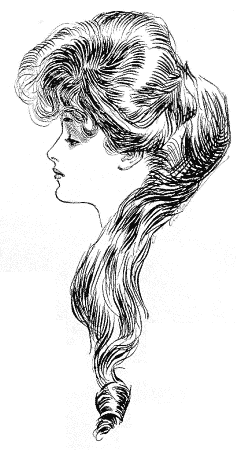
Charles Dana Gibson, one of the country's most renowned artists of the era, used Nesbit as the model for one of his best-known "Gibson Girl" works. Titled "Woman: The Eternal Question" (c.1903), the portrait features her in profile, with her luxuriant hair forming the shape of a question mark.
Glamour photography of women, use of which was then referred to as the "live model" in newspaper and magazine advertising, was still in its infancy, yet gaining in popularity, moving to supplant illustration. Nesbit obtained work modeling for an early pioneer in fashion photography, Joel Feder. The assignments were less strenuous, posing sessions being shorter in duration, and the work was lucrative. While working for Feder, Nesbit earned $5 for a half-day shoot and $10 for a full day – around $300 per day in 2019 dollars. Eventually, the fees she earned from her prolific modeling career exceeded the combined income she, her brother, and mother had earned at Wanamaker's department store in Philadelphia. The high cost of living in New York City, however, still caused strain on their finances.
Chorus girl and actress
Nesbit became disaffected and bored with the long hours spent in confined environments, maintaining the immobile poses required of a studio model. Her popularity modeling had attracted the interests of theatrical promoters, some legitimate and some disreputable, offering her acting opportunities.[20] Nesbit pressed her mother to let her enter the theatre world, and Mrs. Nesbit ultimately agreed to let her daughter attempt this new way to augment their finances. An interview was arranged for the aspiring performer with John C. Fisher, company manager of the wildly popular play Florodora, then enjoying a long run at the Casino Theatre on Broadway. Mrs. Nesbit's initial objections were softened by the knowledge that some of the girls in the show had managed to marry millionaires. In July 1901, costumed as a "Spanish maiden", Nesbit became a member of the show's chorus line, whose enthusiastic public dubbed them the "Florodora Girls". Billed as "Florence Evelyn", the new chorus girl was called "Flossie the Fuss", by the cast, a nickname which displeased her, and induced her to change her theatrical name to Evelyn Nesbit.
After her stint as a "Florodora Girl" ended, Nesbit sought out other theatrical possibilities. She won a part in a production which had just come to Broadway, The Wild Rose. After an initial interview with Nesbit, the show's producer, George Lederer, sensed he had discovered a new sensation. He offered her a contract for a year and, more significantly, moved her out of the chorus line and into a position as a featured player – the role of the Roma girl "Vashti". The publicity machine began to roll, possibly fueled by Stanford White's influence, and she was hyped up in the gossip columns and theatrical periodicals of the day. On May 4, 1902, The New York Herald showcased her in a two-page article, liberally enhanced by photographs, promoting her rise as a new theatrical light, and detailing her career trajectory from model to chorus line to key cast member. "Her Winsome Face to be Seen Only from 8 to 11pm", the newspaper title announced to the public. The press coverage invariably touted her physical charms and potent stage presence; her acting skills were rarely mentioned.
| Nexus: Evelyn Nesbit |
|---|
The following articles are related to "Evelyn Nesbit" as their nexus External links
|
Relationships
Stanford White
Photograph of Stanford White by George Cox, c. 1892
The principals of the McKim, Mead & White architecture firm: William Rutherford Mead, Charles Follen McKim, and Stanford White (left to right) As a chorus girl on Broadway in 1901, Nesbit was introduced to the architect Stanford White by Edna Goodrich, who along with Nesbit was a member of the company of Florodora. White, a womanizer known as "Stanny" by his close friends and relatives, was then 46 years old and Nesbit 15 or 16. He was also married and had a son, but his wife was not much of a presence in his social environment. A practiced voluptuary, White used intermediaries to disarm the girl. Nesbit was initially struck by White's imposing size, which she said "was appalling", and she also said that to her he seemed "terribly old".[1]
"The Red Velvet Swing"
White maintained a multifloor apartment on West 24th Street situated above the toy store FAO Schwarz. The entrance to the apartment was a doorway located adjacent to the store's back delivery entrance. White invited Nesbit and Edna Goodrich to join him there for lunch. In her memoir Prodigal Days, Nesbit described her introduction to White's apartment.[24] She was immediately overwhelmed by the décor; the walls adorned with fine paintings, the ornate, carved furniture, and the heavy red velvet draperies, which were drawn against the afternoon light. The only illumination in the room was the glow of soft light emanating from concealed lighting in the room. The other guest in attendance was an older man whom White introduced as Reginald Ronalds. The luncheon table was laid with food, which to Nesbit was an exotic delight – gourmet dishes prepared by Delmonico's restaurant. She was allowed one glass of champagne. Afterwards, they all ascended two flights up into a room decorated in green where a large, red velvet swing was suspended from the ceiling by ropes entwined with ivy-like vines. Nesbit was amused by the swing and consented to sit in it as White, with increasing momentum, propelled her vigorously into the air. A game ensued whereby Edna Goodrich held a Japanese paper parasol by a cord; the object was for Nesbit's foot to target the parasol, repeatedly swinging and aiming until the parasol was shredded. Nothing improper took place that day other than an aesthetic delight in the day's festivities.
Outwardly a witty, kind, generous man, White was frequently described in the newspapers as "masterful", "intense", and "burly yet boyish". He was able to impress both Nesbit and her mother as an "interesting companion". White moved mother, son, and daughter into a suite at the Wellington Hotel, which he himself had opulently decorated. Nesbit's bedroom was white and rose red, the drawing room a deep green, a reference to the green-hued room at White's 24th Street apartment where the red velvet swing hung from the ceiling.
Mrs. Nesbit grew favorably disposed to Stanford White. His interest appeared genuinely paternal, arranging for her fatherless son, Howard, to attend the Chester Military Academy, near Philadelphia. Over time, White managed to convince Mrs. Nesbit that a brief trip to visit friends in Pittsburgh would be a beneficial respite. He overcame her anxieties concerning her daughter's welfare, left unchaperoned in New York, by pledging his assurance that he would watch over the young girl.
Nesbit wearing flower wreath headband.
Nesbit in a decorative setting "Mirror Room" Several nights after her mother left for Pittsburgh, Nesbit and White were together in his 24th Street apartment. The two dined and drank champagne. White then proceeded to give Nesbit a tour of rooms, with the finale an unveiling of the "mirror room". This 10-by-10-foot room, situated on the same floor where the red velvet swing was installed, had walls and ceiling entirely paneled in mirrors and was furnished with a green velvet sofa. More champagne was consumed and Nesbit changed into a yellow satin kimono. She claimed that this was the last memory she had before losing consciousness. She said she subsequently awoke lying naked in bed next to White, who was also naked, and she noticed blood. She had "entered that room a virgin", but did not come out as one.
Despite what had occurred, Nesbit then became White's regular lover and close companion for a period of some months. At some point, as the intensity of their relationship faded, she also discovered that he had been dallying with other young women, and had been keeping track of them in a "little black book".
John Barrymore
John Barrymore, known as "Jack", had seen the show The Wild Rose at least a dozen times since its opening, so entranced had he become with Nesbit on the stage. The two met at a lavish party given by Stanford White, who had invited Barrymore, the brother of a friend, the stage actress, Ethel Barrymore. In 1902, a romance blossomed between Nesbit and the young Barrymore. It was a unique relationship for her in that the 21-year-old Barrymore was a contemporary, a man close to her own age. He was a witty and fun-loving companion, and Nesbit became smitten with him. After an evening out, the couple often returned to Barrymore's apartment, remaining there together well into the early-morning hours. Avoiding the family path of entering the acting world, Barrymore was casually pursuing a career as illustrator and cartoonist. Although he showed some promise in his chosen field, his salary was small and he was behaving irresponsibly with the family money, and Nesbit's mother and White considered him an unsuitable match for her 16–17-year-old daughter. Both Mrs. Nesbit and White were greatly displeased when they found out about the relationship. White engineered a plan to separate the couple by arranging for Nesbit's enrollment in a boarding school in New Jersey administered by Mathilda DeMille, the mother of the film director Cecil B. DeMille. In the presence of both Mrs. Nesbit and White, Barrymore had asked Nesbit to become his wife, but she turned down his marriage proposal. Many decades later, Barrymore's nephew Samuel Colt (Ethel's son) made an uncredited appearance in The Girl in the Red Velvet Swing, a 1955 movie about Nesbit.
Harry Kendall Thaw
Harry Kendall Thaw, husband of Nesbit
Nesbit, c. 1903 Aside from her relationship with Barrymore, Nesbit was involved with other men who vied for her attention as her sexual relationship with White faded. Among those were the polo player James Montgomery Waterbury, also known as "Monte", and the young magazine publisher Robert J. Collier. Throughout these relationships, White still remained a potent presence in her life, maintaining his position as benefactor.
The association which would come to dominate Nesbit's life, however, came in the person of Harry Kendall Thaw, the son of a Pittsburgh coal and railroad baron. With a history of pronounced mental instability dating back into his childhood, Thaw, heir to a $40 million fortune, led a reckless, self-indulgent life. Thaw had been in the audience of The Wild Rose, attending some forty performances for the better part of a year. Even before he met Nesbit, Thaw had a burning resentment for White, who he thought had blocked Thaw's acceptance in social circles and was a womanizer who preyed on very young women. Thaw may have even chosen Nesbit as the focus of his attention because of her relationship with White.
Through an intermediary, Thaw ultimately arranged a meeting with Nesbit, introducing himself as "Mr. Munroe". Thaw maintained this subterfuge, with the help of confederates, while showering her with gifts and money, before he felt the time was right to reveal his true identity. With characteristic eccentricity, the day came when he confronted Evelyn and announced: "I am not Munroe ... I am Harry Kendall Thaw, of Pittsburgh!" She did not react with such surprise as he had expected. She was rather indifferent about his revelation, as she was already used to being the focus of wealthy men's attentions, and the fact that he was wealthy had already been evident.
Trip to Europe
While at the boarding school, Nesbit underwent emergency surgery in early 1903. The nature of the surgery has been a subject of some controversy. The official diagnosis was acute appendicitis; however, some sources have speculated that she had been pregnant (perhaps by Barrymore) and had an abortion. Evelyn's grandson, Russell Thaw, has said: "I think she went away to have an abortion." However, under oath at Thaw's murder trials, both Barrymore and she subsequently denied any pregnancy or abortion.
Evelyn's medical situation elicited the solicitous side of Thaw. He ensured that she received the best medical care available, and then promoted the idea that she should go on a European trip, convincing Evelyn and her mother that such a pleasure excursion would hasten Evelyn's recovery from the surgery. Evelyn's mother accompanied them on the trip for reasons of propriety. However, the trip proved to be anything but recuperative. Thaw's hectic mode of travel escalated into a nonstop itinerary, seemingly calculated to weaken Evelyn's emotional resilience and compound her physical frailty, and also to unnerve and exhaust Mrs. Nesbit. As tensions mounted, mother and daughter began to quarrel, leading to Mrs. Nesbit's insistence on returning to America. Having effectively alienated her from her mother, Thaw then took Evelyn to Paris, leaving Mrs. Nesbit in London.
The Confession In Paris, Thaw pressed Evelyn to become his wife, but she refused. Aware of Thaw's obsession with female chastity, she could not in good conscience accept his marriage proposal without revealing to him the truth of her relationship with White. What followed was a marathon session of inquisition, during which time Thaw managed to extract every detail of that night: how, when plied with champagne, Nesbit lay intoxicated, and unconscious, while White "had his way with her". Throughout the grueling ordeal, Evelyn was tearful and hysterical; Thaw by turns was agitated, weeping, and gratified by her responses. He further drove the wedge between mother and daughter, condemning Mrs. Nesbit as an unfit parent. Evelyn blamed the outcome of events on her own willful defiance of her mother's cautionary advice and defended her mother as naïve and unwitting.
The Castle Thaw and Evelyn continued their travel through Europe. Thaw, as guide, chose a bizarre agenda, a tour of sites devoted to the cult of virgin martyrdom. In Domrémy, France, the birthplace of Joan of Arc, Thaw left a telling inscription in the visitor's book: "she would not have been a virgin if Stanford White had been around."
This was where Evelyn, to her horror, was locked in her room by Thaw, whose persona took on a dimension she had never before seen. Manic and violent, he beat her with a whip and sexually assaulted her over a two-week period. After his reign of terror had been expended, he was apologetic, and incongruously, after what had just happened, was in an upbeat mood.
On her return to New York from Europe, in the company of friends, Evelyn unburdened herself, disclosing the ordeal of her imprisonment in the Austrian castle. Only then did others come forward with dark disclosures about Thaw and his propensity toward myriad addictive behaviors. From several men, she was told that Thaw "took morphine" and that "he was crazy."
Marriage Although he was still a part of her life, over time, Evelyn came to realize that she had no future with White. She also knew her entanglement with White had compromised her reputation; if the extent of their involvement became common knowledge, no respectable man would make her his wife. She also harbored some resentment towards White, faulting him for never being candid with her about Thaw's excesses and derangement.
As a teenager, Evelyn had spent her formative years thrust into the adult society of artists and theatre people; her development had proceeded without the companionship of contemporaries of her own age. Her mother had remarried, and although she had been an inept guardian, their estrangement was now a fact; the new Mrs. Charles Holman was now effectively out of her daughter's life. Evelyn also feared a renewal of the poverty and deprivation that she and her family had suffered for many years. Her vulnerability and isolation became palpable.
"Lyndhurst" (William and Mary C. Thaw mansion), Pittsburgh, Pennsylvania (demolished, c. 1942)
Thaw had pursued Evelyn obsessively for nearly four years, continuously pressing her for marriage. He told her he would change his behavior and that once they were married, he would live the life of a "Benedictine monk". Thaw was contrite about what had occurred at the Austrian castle. His explosive anger and rage had been directed at White, whom he called "The Beast". He knew Nesbit had been White's victim. Thaw, with a perverted sense of justice, and a show of magnanimous charity, assured Nesbit he had forgiven her.
Craving financial stability in her life, and keeping Thaw's "sweet, generous, and gentle side" to the forefront, Evelyn finally consented to become his wife. "Mama Thaw", Thaw's mother, agreed to the marriage, decreeing that her future daughter-in-law give up the theatre and modeling and that her past life be forever obliterated; it was never to be talked of or referred to.
Evelyn and Thaw were married on April 4, 1905. Thaw himself chose Evelyn's wedding dress. Eschewing the traditional white gown, he dressed her in a black traveling suit decorated with brown trim. Newspapers announced that the new Mrs. Thaw was now the "Mistress of Millions".
The two took up residence in the Thaw family home, Lyndhurst, in Pittsburgh. Isolated with Mama Thaw, subject to her strict religious precepts and the puritanical like-minded social group which assembled in the Thaw home, Evelyn became the proverbial bird in a gilded cage. In later years, she took measure of life in the Thaw household, saying that the Thaws were anything but intellectuals and that their value system was shallow and self-serving: "the plane of materialism which finds joy in the little things that do not matter – the appearance of ... [things]".
Envisioning a life of travel and entertaining, the newly wed Mrs. Harry Kendall Thaw was rudely awakened to a reality markedly different. Thaw himself entered into his mother's sphere of influence, seemingly without protest, taking on the pose of pious son and husband. At this time, Thaw instituted a zealous campaign to expose White, corresponding with the reformer Anthony Comstock, the crusader for moral probity and the expulsion of vice. Because of his activity, Thaw became convinced that he was being stalked by members of the notorious Monk Eastman Gang, hired by White to kill him. Thaw started to carry a gun. Evelyn later corroborated his mindset: "[Thaw] imagined his life was in danger because of the work he was doing in connection with the vigilance societies and the exposures he had made to those societies of the happenings in White's flat."
The killing of Stanford White Stanford White himself was thought to be unaware of Harry Kendall Thaw's long-standing vendetta against him. White considered Thaw a poseur of little consequence, categorized him as a clown, and most tellingly, called him the "Pennsylvania pug,” a reference to Thaw's baby-faced features.
June 25, 1906, was an inordinately hot day. Thaw and Nesbit were stopping in New York briefly before boarding a luxury liner bound for a European holiday. Nesbit had been tense and uneasy throughout the day, as Thaw spent the day in and out of their hotel suite ostensibly taking care of last-minute details for their voyage. Late that day, Thaw disclosed his plans for the evening. He had purchased tickets for a new show, Mam'zelle Champagne, written by Edgar Allan Woolf, premiering on the rooftop theatre of Madison Square Garden. Accompanying them would be two of Thaw's male friends. They first stopped at the Cafe Martin, where they inadvertently saw Stanford White, before proceeding on to Madison Square Garden. In spite of the suffocating heat, which did not abate as night fell, Thaw inappropriately wore a long black overcoat over his tuxedo, which he refused to take off throughout the entire evening.
At 11:00 pm, as the stage show was coming to a close, Stanford White appeared, taking his place at the table that was customarily reserved for him. Thaw had been agitated all evening, and abruptly bounced back and forth from his own table throughout the performance. Spotting White's arrival, Thaw tentatively approached him several times, each time withdrawing in hesitation. During the finale, "I Could Love A Million Girls", Thaw produced a pistol, and standing some 2 feet from his target, fired three shots into Stanford White's head and back, killing him instantly. Parts of White's face and skull were torn away and the rest of his features were unrecognizable, blackened by gunpowder. Thaw remained standing over White's fallen and bleeding body, displaying the gun aloft in the air, addressing the crowd. Witness reports differ as to the exact pronouncements Thaw made, and while the specific wording varies, all share a similar theme: "I did it because he ruined my wife! He had it coming to him. He took advantage of the girl and then abandoned her! ... You'll never go out with that woman again." In his book The Murder of Stanford White, Gerald Langford quoted Thaw as saying "You ruined my life", or "You ruined my wife", and The New York Times account the following day stated, "Another witness said the word was "wife" instead of "life", contradicting the report made by the arresting officer.
The crowd initially suspected the shooting might be part of the show, as elaborate practical jokes were popular in high society at the time. Soon, however, it became apparent that Stanford White was dead. Thaw, still brandishing the gun high above his head, walked through the crowd and met Nesbit at the elevator. When she asked what he had done, Thaw said that he had "probably saved [her] life".
As Thaw was taken into police custody, Nesbit managed to extricate herself from the ensuing chaos on the Madison Square rooftop. Not wanting to return to the hotel suite she shared with Thaw, she took refuge for several days in the apartment of a chorus girl with whom she had struck up a friendship. Years later, Nesbit described her traumatic condition: "A complete numbness of mind and body took possession of me ... I moved like a person in a trance for hours afterward."
Death
Nesbit died in a nursing home in Santa Monica, California, on January 17, 1967, at the age of 82. She was buried at Holy Cross Cemetery in Culver City, California.
- More information is available at [ Wikipedia:Evelyn_Nesbit ]
Chat rooms • What links here • Copyright info • Contact information • Category:Root
